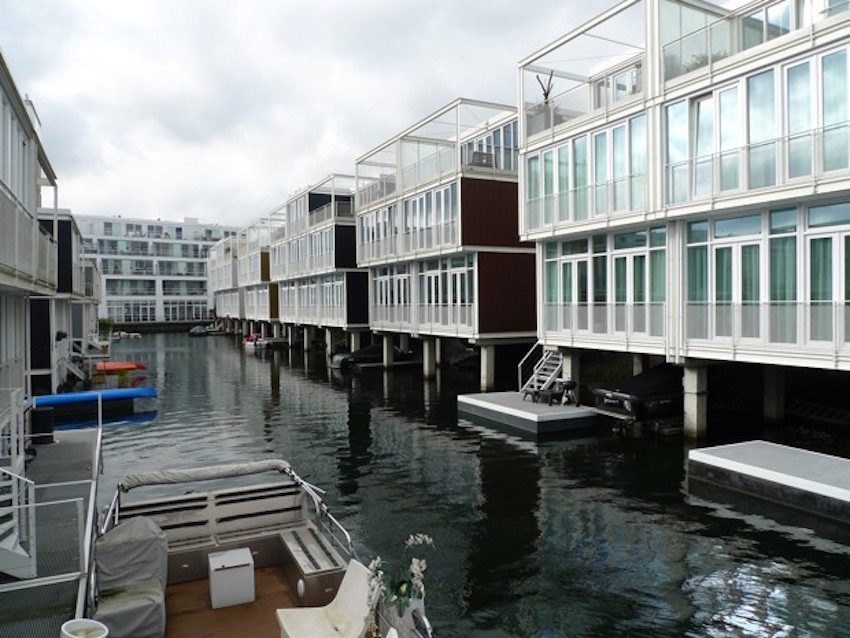The city plans to wean its homes off domestic natural gas by 2050, starting now.

By 2050, Amsterdam hopes to put its gas-heated days behind it. In a city where natural gas warms 90 percent of all homes and contributes 30 percent of all carbon emissions, removing all those boilers won’t be easy—but it could very well be worth it.
From here, the deadline might seem far away, but the journey to that target is beginning right now. This week, the city announced that in 2017, 10,000 public housing units will have their gas supplies removed, and new neighborhoods in the city won’t have natural gas as an option either.
So what will heat Amsterdam in the future? The overarching answer is district heating, derived from a number of sources. By 2020, 102,000 Amsterdam homes will have switched from heat created in their homes to heat created at a central facility and supplied by a pipeline. While it requires a network of heavily insulated hot water pipes to be installed, district heating systems save considerable energy in the long run by creating a single generating point where fuel is burned. This creates efficiencies of scale that ultimately make the same amount of fuel go further.
Even if this heat were to be generated by natural gas, heating water centrally and piping it to heaters, kitchens, and bathrooms would produce far fewer carbon emissions than burning gas in each home. But in a general move against the fuel, Amsterdam is already trying to find alternative heat sources, notably waste heat from industry. Already, 70,000 of the city’s homes are warmed with water heated at a central waste incinerator. The plan is to roll this concept out further to tap into other sources of waste heat.
From our partners:
The plans are not all working toward greater centralization, however. Some heat pumps are being planned to keep homes warm on the new artificial islands Amsterdam has been constructing in the IJmeer lake. Some homes are also being fitted with solar water heaters, which will ultimately be able to feed unused hot water back into the wider network to generate income for the homeowner.
This all makes it sound pretty simple, but the issues ahead are still pretty huge. For heat pumps to be cost effective, for example, buildings need to be extremely well insulated, which could be why only around 1,000 Dutch homes are currently fitted with the technology. That’s an easy enough goal to manage for new construction, but it would be far harder to install in the city’s older, often rather drafty housing stock.
Meanwhile, district heating needs to be very carefully regulated. When a single supplier installs and owns the pipe network, they have a monopoly over the area they supply. This issue is currently managed by mandating that district heating costs no more than any provider on the conventional fuel markets. Local government magazine Binnenlands Bestuur still suggests that gas heating of some sort may persist in Amsterdam’s core, where buildings are currently unsuitable for heat pumps and laying pipes in narrow streets could cause major disruption—even if it’s more likely to do so in the form of more biogas than natural gas.
To plan changes like these suggests a high level of commitment to green energy, consistent with the culture of a country whose widespread historic use of wind power and vulnerability to sea level rise makes the greening of infrastructure an easier sell to the public. The reasons for the planned switch are also geopolitical, however. Like the rest of Europe, the Netherlands relies partly on Russian gas imports, up to 50 percent of which need to flow via pipeline through Ukraine. Disagreements between Moscow and Kiev have led to gas supply disruptions in the past, and the Russian government sometimes uses gas diplomacy as a form of leverage with its neighbors.
This doesn’t always work, but the Netherlands and other E.U. states clearly dislike the potential instability of relying on Russian resources. The Dutch are in a better position than most because, as the E.U.’s largest gas producer, they can meet 70 percent of their gas needs domestically. They have problems here too, as gas extraction around the northern city of Groningen has led to over 1,000 earthquakes since 1986, despite the area being nowhere near a fault line. Most of these tremors are tiny, but cracked brickwork and masonry have become a common sight in the area and some buildings have become structurally unsound. It would be hard to give up this source of revenue even if Dutch gas were entirely exported — except that Dutch gas is “low calorie” high nitrogen gas that would provide little competition for Russian gas internationally.
It doesn’t make a whole lot of sense to heat homes with gas when gas extraction is shaking those homes’ foundations. Amsterdam’s plans for a gas-free future aren’t thus evidence of a utopian commitment to cutting emissions. They’re also a pragmatic idea designed to wean the city off of a fuel whose use comes with too many strings attached.
This feature originally appeared in Citylab.















